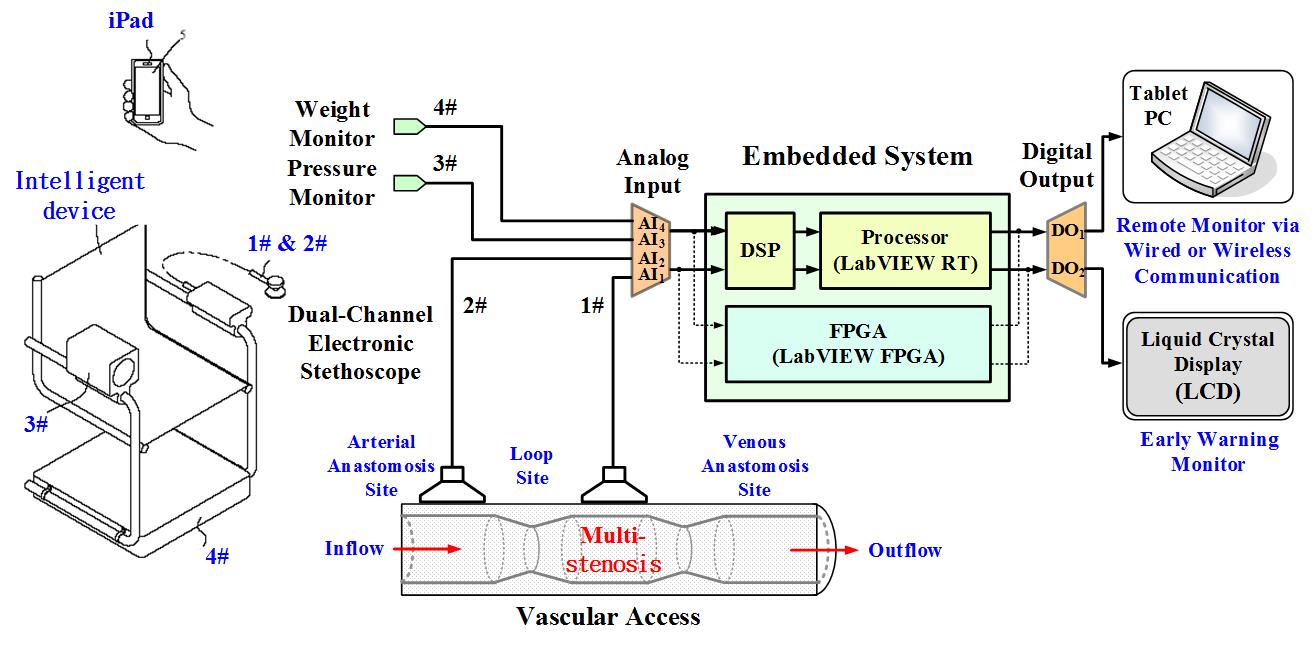Assessment of Arteriovenous Shunt Pathway Function and Hypervolemia for Hemodialysis Patients by Using Integrated Rapid Screening System
Keywords:
arteriovenous shunt, screening system, hypervolemia, dual-core embedded systemAbstract
Currently, the hemodialysis patients received body weight measurement by themselves, vital sign checking by nursing staffs before dialysis. Whenever, the arteriovenous routes with problems doubted, the patients needed to be referred to surgeon for vascular echography checking and then to be corrected. How to integrate these three tasks in one time is a very important issue. The project proposes to combine our previous study of audio-phono angiographic technology in detecting vascular stenosis with rapid screening system to evaluate dialysis patients’ arteriovenous routes function and their status of excess body fluids: inspecting and integrating the blood pressure, body weight, and fistula function work into a rapid screening system, and using the quantization of fistula phono angiography pitch to achieve assessing arteriovenous routes. Future hoping is developed a complete integrated intelligence system by combining the arteriovenous fistula signal processing with feature extraction with wireless sensor network technology.References
A. J. Collins et al., “USRDS 2012 annual data report: atlas of chronic kidney disease and end-stage renal disease in the United States,” American J. Kindeny Diseases, vol. 59, pp. 342, 2012.
N. K. Foundation, “KDOQI clinical practice guidelines and clinical practice recommendations for 2006 updates: hemodialysis adequacy, peritoneal dialysis adequacy and vascular access,” Am. J. Kidney Dis., vol. 48, pp. 1-322, 2006.
F. Loth, P. F. Fischer, and H. S. Bassiouny, “Blood flow in end-to-side anastomoses,” Annu. Rev. Fluid Mech., vol. 40, pp. 367-393, 2008.
P. W. Chamney, K. Matthias, C. Rode, W. Kleinekofort, and V. Wizemann, “A new technique for establishing dry weight in hemodialysis patients via whole body bioimpedance,” Kidney International, vol. 61, pp. 2250-2258, 2002.
A. H. Tzamaloukas, G. H. Murata, D. J. Vanderjagt, K. S. Servilla, and R. H. Glew, “Body composition evaluation in peritoneal dialysis patients using anthropometric formulas estimating body water,” Advances in Peritoneal Dialysis, vol. 19, pp. 212-216, 2003.
R. Agarwal, “Hypervolemia is associated with increased mortality among hemodialysis patients,” Hypertension, vol. 56, pp. 512-517, 2010.
Y. C. Du, W. L. Chen, C. H. Lin, C. D. Kan, and M. J. Wu, “Residual stenosis estimation of arteriovenous grafts using a dual channel honoangiography with fractional-order features,” IEEE Journal of Biomedical and Health Informatics, vol. 18, no. 2, pp. 703-713, 2014.
W. L. Chen, C. H. Lin, T. Chen, P. J. Chen, and C. D. Kan, “Phono angiography with a fractional order chaotic system - A new and easy algorithm in analyzing residual arteriovenous,” Medical & Biological Eng & Computing, vol. 51, pp. 1011-1019, 2013.
W. L. Chen, C. H. Lin, T. Chen, P. J. Chen, and C. D. Kan, “Stenosis detection using burg method with autoregressive model for hemodialysis patients,” Journal of Medical and Biomedical Engineering, vol. 33, no. 4, pp. 356-362, 2013.
R. S. Lees and C. F. Dewey, “Phono angiography: a new noninvasive diagnostic method for studying arterial disease,” Proceedings of the National Academy of Sciences, vol. 67, no. 2, pp. 935-942, 1970.

Published
How to Cite
Issue
Section
License
Submission of a manuscript implies: that the work described has not been published before that it is not under consideration for publication elsewhere; that if and when the manuscript is accepted for publication. Authors can retain copyright in their articles with no restrictions. is accepted for publication. Authors can retain copyright of their article with no restrictions.
Since Jan. 01, 2019, AITI will publish new articles with Creative Commons Attribution Non-Commercial License, under The Creative Commons Attribution Non-Commercial 4.0 International (CC BY-NC 4.0) License.
The Creative Commons Attribution Non-Commercial (CC-BY-NC) License permits use, distribution and reproduction in any medium, provided the original work is properly cited and is not used for commercial purposes.



